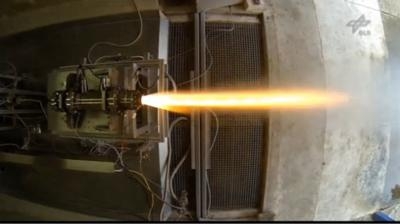Fri, Jan 31, 2014
DLR Engineers Research Tomorrow's Hybrid Engines
The concrete tube stretching across the German Aerospace Center (Deutsches Zentrum für Luft- und Raumfahrt; DLR) site in Trauen might be less than 11 feet wide, but every now and then it becomes outer space for around 10 seconds. This is the case when engineers at the DLR Institute of Aerodynamics and Flow Technology put their newly developed hybrid rocket engine through its paces.

Researchers take seats behind the 8-inch-thick, reinforced concrete walls in the control room while, in the test stand, liquid hydrogen peroxide reacts with solid fuel in a combustion chamber producing 530 pounds of thrust in the rocket engine. The first analyses of the Advanced Hybrid Rocket Engine Simulation (AHRES) project show that it might take just five to 10 years to develop an airworthy hybrid engine to launch a rocket into space.
By combining a solid propellant and liquid oxidizer in one engine, the DLR researchers hope to benefit from the advantages of both systems: "They are easier to build and handle than liquid propellant engines, which makes them less costly, and the fuels are not toxic," says DLR engineer Daniel Lancelle, listing the advantages. "You can control the thrust and ignite or switch off the engine as needed. The risk of explosion is also reduced in comparison with other engines." But the scientists are aware of the drawbacks of a hybrid engine – a lower combustion rate and reduced thrust. "At the moment we are working on understanding this new kind of engine and on improving the combustion rate and engine efficiency," explains researcher Ognjan BoA3/4iA. "And so far the results are promising."
A team comprised of DLR staff and students took it upon themselves to give the test stand at the DLR site in Trauen – unused for some 30 years – a makeover, installing state-of-the-art technology. Their purpose was to demonstrate that the hybrid rocket engine they had designed could work at least as efficiently as standard solid propellant engines. "You will not find another facility like this one in Europe," emphasizes Ognjan BoA3/4iA. The remote location of Trauen complies with all the safety standards required to plan future tests on larger engines with a thrust of up to 15 tons. Here, the engineers conduct tests with various solid fuels, modify the mixtures and analyze the course of combustion. The test results are then used to optimize the computer simulations.
This type of hybrid rocket engine could, for example, be used as the upper stage of a small to medium-sized launcher. "They can be deployed in research rockets and research aircraft operating at an altitude ranging from 40 to 180 kilometers – and therefore bridge the gap between airplanes and satellites," says project manager BoA3/4iA. They could also be used for spacecraft landings on the Moon and Mars. Their high degree of safety due to the separation of the different fuels before ignition opens up yet another field of application: space tourism.
"Our objective is to use the results obtained to develop engineering software that could be used by industry or research institutions to design this kind of engine or improve an existing design in just a few weeks," says DLR engineer Dennis Porrmann. Ognjan BoA3/4iA, Daniel Lancelle and Dennis Porrmann plan to conduct at least five more trials by mid-2015.
(Image provide by DLR)
More News
Aero Linx: International Federation of Airworthiness (IFA) We aim to be the most internationally respected independent authority on the subject of Airworthiness. IFA uniquely combi>[...]
Ultrahigh Frequency (UHF) The frequency band between 300 and 3,000 MHz. The bank of radio frequencies used for military air/ground voice communications. In some instances this may >[...]
A Few Questions AND Answers To Help You Get MORE Out of ANN! 1) I forgot my password. How do I find it? 1) Easy... click here and give us your e-mail address--we'll send it to you >[...]
From 2019 (YouTube Edition): Learning To Paint Without Getting Any On Your Hands PPG's Aerospace Coatings Academy is a tool designed to teach everything one needs to know about all>[...]
Also: Sustainable Aircraft Test Put Aside, More Falcon 9 Ops, Wyoming ANG Rescue, Oreo Cookie Into Orbit Joby Aviation has reason to celebrate, recently completing its first full t>[...]
 ANN's Daily Aero-Linx (05.06.25)
ANN's Daily Aero-Linx (05.06.25) ANN's Daily Aero-Term (05.06.25): Ultrahigh Frequency (UHF)
ANN's Daily Aero-Term (05.06.25): Ultrahigh Frequency (UHF) ANN FAQ: Q&A 101
ANN FAQ: Q&A 101 Classic Aero-TV: Virtual Reality Painting--PPG Leverages Technology for Training
Classic Aero-TV: Virtual Reality Painting--PPG Leverages Technology for Training Airborne 05.02.25: Joby Crewed Milestone, Diamond Club, Canadian Pilot Insurance
Airborne 05.02.25: Joby Crewed Milestone, Diamond Club, Canadian Pilot Insurance



